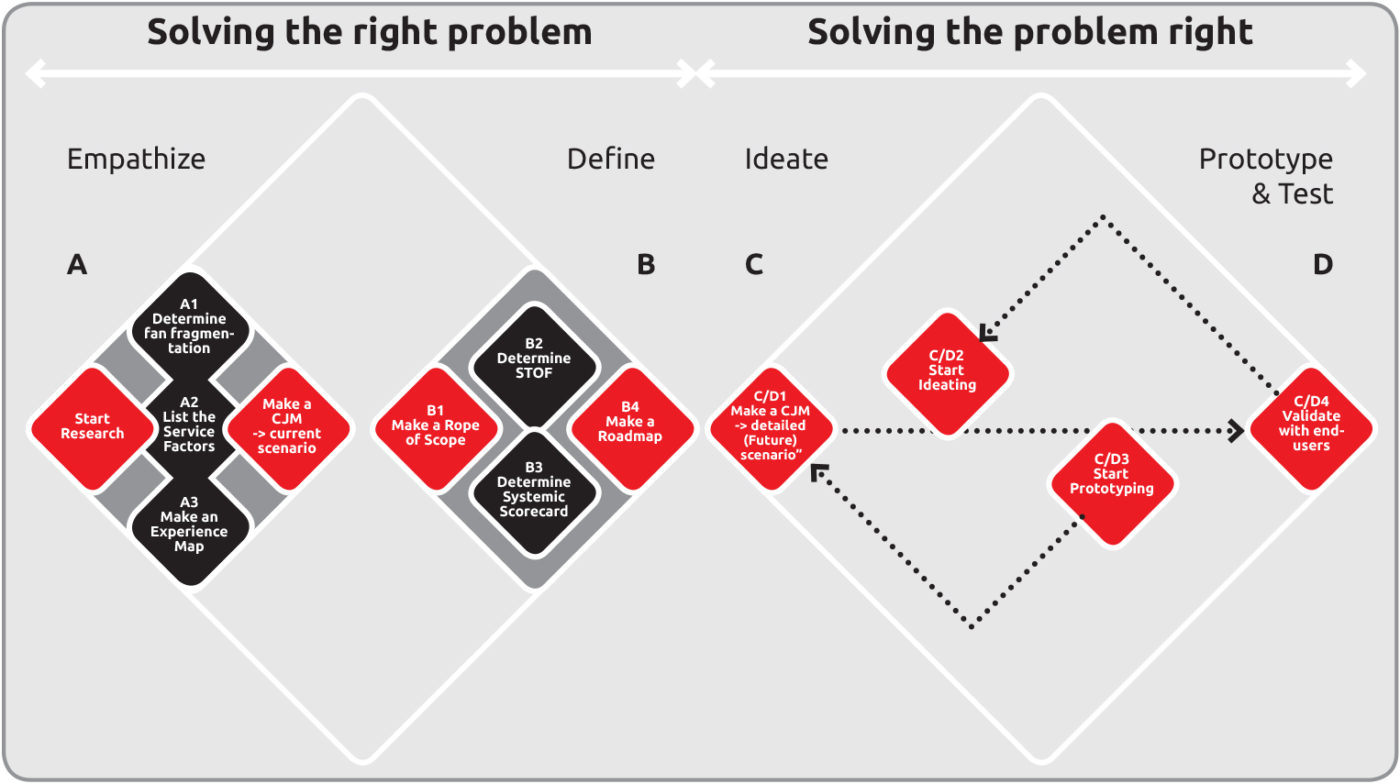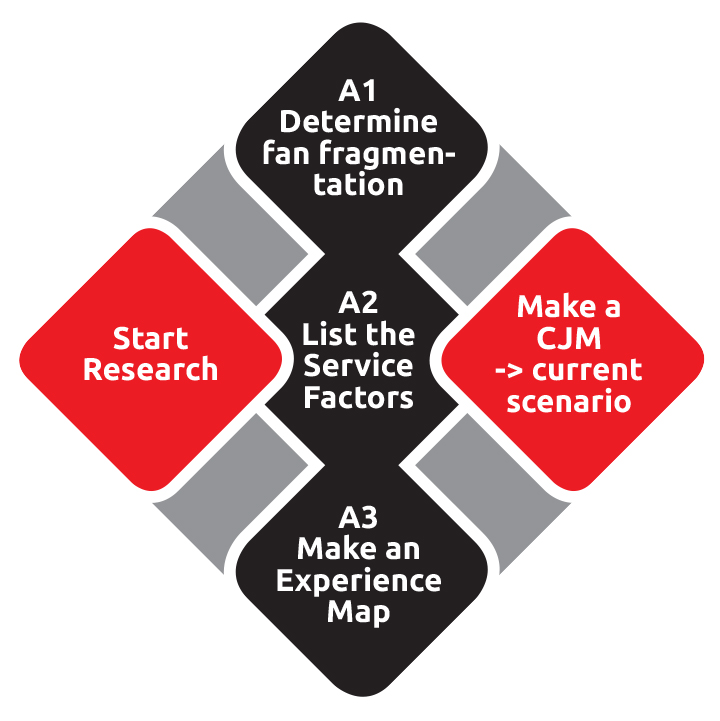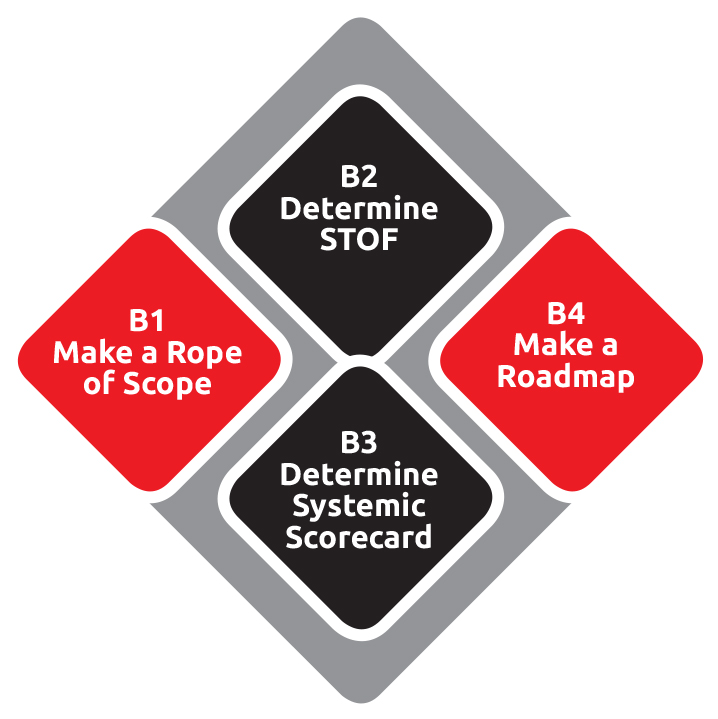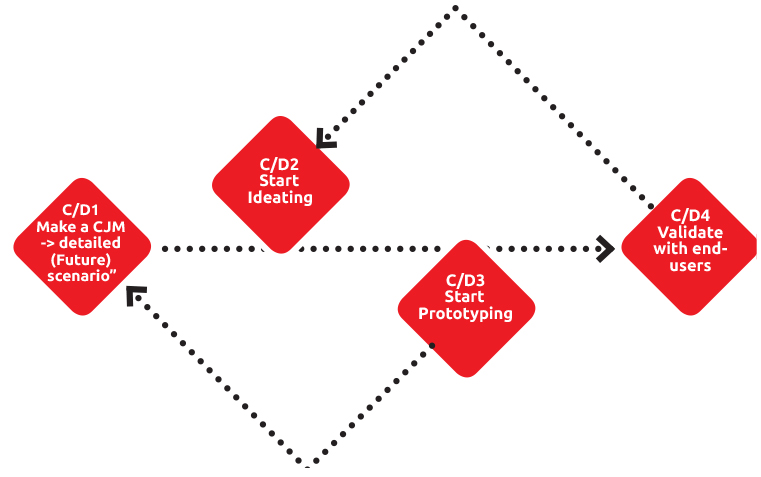How to use the Double Diamond
The methods explained in the Research section of this website are summed up below and serve as a guide for making decisions on management level in the field of “Fan Experiences”, or will help you during your own creative process.
Why would you want to follow these steps? Each service, product or innovation is not necessarily the perfect fit at this moment, with certain stakeholders, or for specific end-users. It is cheaper to adopt an Agile or LEAN way of improvement instead of realising that the service is not so optimal after all and a lot of money and resources are wasted.

A – Empathize
Start your investigation by following these steps:
Determine what the characteristics of your fans or target groups are. Use the information from the fan motivations and fragmentation section including examples of 6 segmentations to help you focus on specific goals and needs of fans.
List the Service Factors which are currently present and which ones should be worth focussing on in the near or far away future.
Make an Experience Map to gather insights based on your own company, service or future innovation. Ask yourself the following questions; When do you target your fans or customers, what do they need, do, feel, and see, is this before, during, or after a match (phases), and what are bottlenecks and opportunities to improve both the physical and digital experience?
- Distinguishing the phases when something happens is important.
- The 16 Service Factors can be used as questions to check whether these important topics are related or not and in what way.
- Taking a look at all of the 25 “Change the Game” innovations will show you examples of how this can be done. They are combined in one big Experience map to show possible relations more clearly. These innovations can be used as a benchmark tool to see how your innovation would “score” during certain phases.
- Additionally 4 of the 12 Case studies, that were used for prototyping, explain more in depth what the use and relation is of the Experience Map, Phases and 16 Service Factors. Use the template from one of these studies, for instance;
- list the characteristics of your intended target group (see step 3),
- make an emotion line to visualise the feelings of fans during each phase of the total experience,
- try to fill out each block in every line in the Experience Map to focus more in depth on touchpoints, actions, communications, opportunities or other topics.
- Setting up multiple target groups will help to identify the needs and wants and make it possible to quantify and objectively list what might be essential or desirable.
Make a Customer Journey Map (CJM) for the current state of the innovation. The current state is important to gather all the insights of your research and to see which elements might need further investigation.
- Same as mentioned in the description of the Experience Map, it is important to define the phases and other variables you want to focus on.
- Every situation is different and therefore a CJM is never a copy-paste or a simple visual representation.
- It is a tool for communication and collaboration on a more detailed level than an Experience Map for a specific flow.
- Multiple CJM’s can be constructed for different targets groups or different parts of the entire flow.

B – Define
After the first level of research, two other methods called STOF Business Model (STOF) and Systemic Scorecard (SSC) will create more nuances and details for the implementation of a new direction or improvement of a service or innovation.
(optional) It is very useful to Make a Rope of Scope to categorise all the insights into a presentable sheet of information. This step is explained in creative sessions:
- Doing this intermediate step will make sure there will be a discussion about future possibilities. The key steps are to determine which elements of the service are IN or OUT of scope, suitable for the near or far away future, or which ones are hard to reach or need further investigation.
- Actively listing and debating with several people is needed at this point to rule out fixed assumptions.
- This Design thinking phase is explained more in depth in the Creative sessions section. This step is not only suitable for creative processes, but can be part of a session with the higher level management or involved stakeholders.
Determine STOF characteristics (4 elements):
- focus on service, technology, organisation and finance,
- suitable for only one service, product or innovation (most likely your own service).
Determine SSC characteristics (4 elements):
- focus on stakeholder value, customer value, Network Extended Business Processes and Systemic Change and Renewal,
- suitable for a combination of services from stakeholders or other related elements that could be of any influence.
Make a Customer Journey Map (CJM) for the current state of the innovation. The current state is important to gather all the insights of your research and to see which elements might need further investigation.
- Same as mentioned in the description of the Experience Map, it is important to define the phases and other variables you want to focus on.
- Every situation is different and therefore a CJM is never a copy-paste or a simple visual representation.
- It is a tool for communication and collaboration on a more detailed level than an Experience Map for a specific flow.
- Multiple CJM’s can be constructed for different targets groups or different parts of the entire flow.

C / D – Ideate, prototype and test
The next steps resemble the approach of a typical Design Thinking process. These phases can be repeated many times (iterations) and sometimes small parts of the prototype can already be tested in an early stage. This is also called Agile or LEAN design and usually involves several steps to change and optimise the design “on the go” compared to a more traditional way of development and implementation when all the functionalities are mostly listed from the very start of the project.
Before starting the Ideation phase, a future scenario of the Customer Journey Map can be made to visualise and scope the intended functionalities and relations with other elements of the total experience of the fan:
- Using different viewpoints (stakeholders) can be useful to create fitting stories, because all (segments of) fans have different preferences and needs.
- a Customer Journey Map is a complex visualisation of numerous factors, phases and relationships with end-users, stakeholders etc.
- A future scenario is always fictive and caution needs to be taken into consideration to not make it a complete “happy flow”.
- It is a “work in progress” tool which cán and shóúld be used for improvement, showing pain points, issues and expected opportunities if implemented in the right way.
- It is a tool for communication of insights rather than a perfect story.
- Traditionally, design goes through some steps to create options and directions of the intended service or product. Concepts are made, based on research and fitting to user needs.
- On this website, examples of this process can be found in the prototyping section.
- Based on concepts, low fidelity and high fidelity prototypes can be developed.
- These prototypes are needed to determine whether the chosen direction is fitting or not, and what alterations might be needed for optimisation.
- Multiple versions of the service and specific parts of an interaction can be tested by means of prototypes.
- Testing itself is important and not always easy. Finding the right subjects to test with and not leading them to answer to your questions in an intended way can reveal gaps in the design and shortcoming.
- A perfect design will never exist from the start. Involving end-users and related stakeholders usually give fruitful insights.
- All these results are needed to validate prototypes and make it possible to identify improvements or show that certain goals are met.
- If a first version of a functional product or service is ready (after testing, iterating and validating), it can be implemented for production or set to a live working environment.
- Even after “going live” it is important to keep testing and improving on a regular basis until a stable solution is present.

disclaimer; these methods work best when guided by a professional, or if methods are done in the right way on your own. The results are always part of a critical thinking process which could create knowledge gaps by improper or incomplete research or when there are too many “unknowns”. Going back to the start or trying to redo some of the steps might be useful or otherwise try to gather more insights before continuing to the next step.
